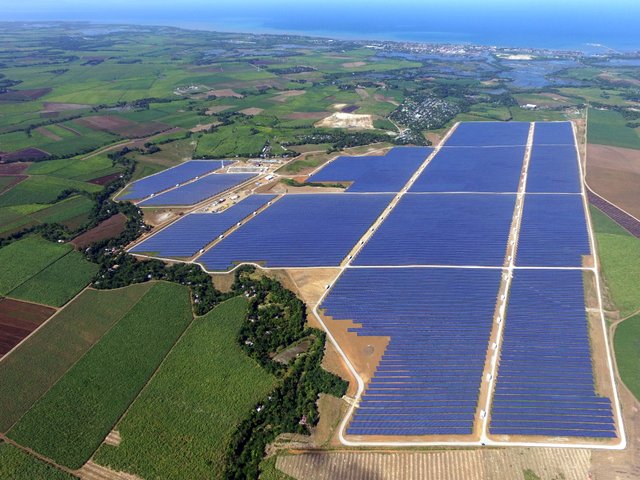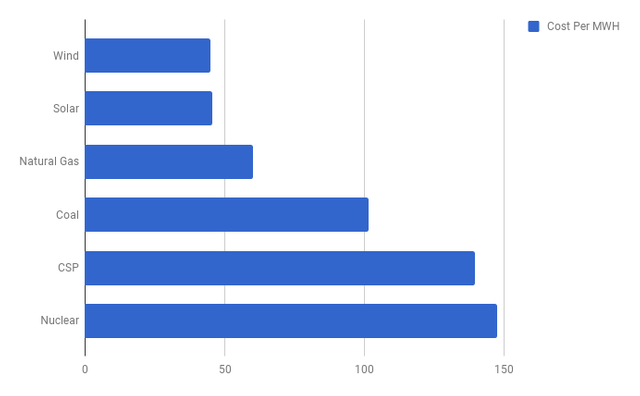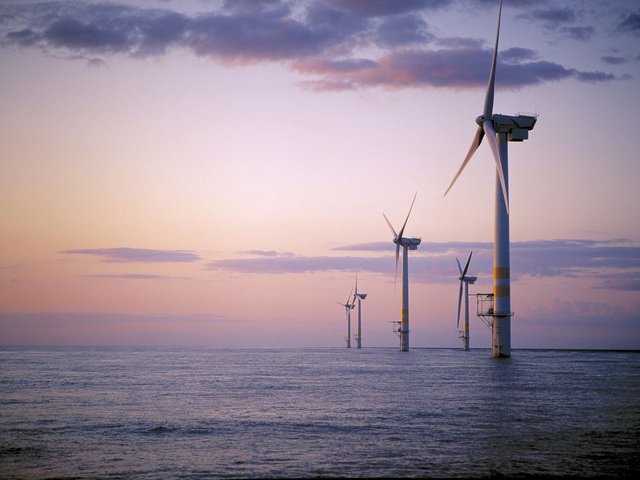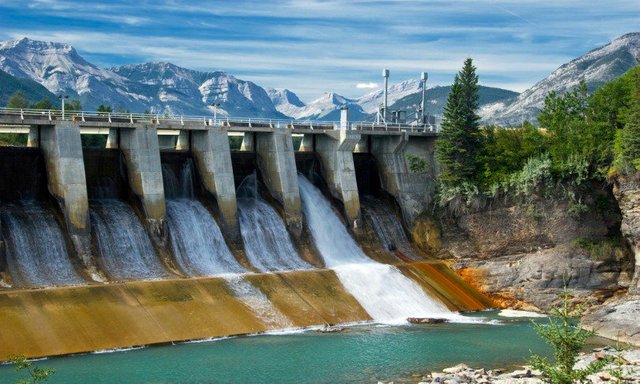The Economics Of Renewable Energy Explained (For Beginners)

Renewable energy has been leading possibly the greatest energy transition in recent memory. The change has been rapid, but there is still far to go. Solar generation accounts for about 1.3% of all electricity generated. Wind power produced about 3.5% in 2015, but is likely closer to 5% for 2017. None the less, renewable energy production still represents a small portion of overall energy production.
These shares are rising fast. The International Energy Agency has predicted solar power could provide 27% of all electricity by 2050. With these rapid rates of growth, renewable energy will only play a bigger role in our future.
However, one of the most common criticisms against renewable energy is it's too expensive. Skeptics will say that the rise of renewable energy will accompany skyrocketing costs in your electricity bills. So, are these claims true? If so, how true?

How We Measure Costs Of Electricity
While you would think this is simple, it's actually quite complicated. There are many ways, and different metrics used to accomplish this. We are going to use a metric called the Levelized Cost Of Electricity, or LCOE for short. It's the most common metric, and it's the easiest to build on to make sure we get the whole picture at the end.
The LCOE is essentially the average an electricity producer would have to sell their electricity for over the lifetime of the plant in order to break-even. In short, it includes capital costs, running costs, and all other associated costs to the electricity producer.
LCOE Of Different Energy Sources
Many different agencies release LCOE figures. In this case, we are going to use figures from Lazard, found here. Lazard is one of the largest investment banks in the world, and they have sound methodology. However, just as important is their numbers are recent (published November 2, 2017). With fast declining costs of renewable energy, being as recent as possible is very important.
Anyways, here are the numbers in USD per MWh of electricity produced. It provides the range with the median in brackets:
Solar PV: 43-48 (45.5)
Concentrated Solar Plant With Storage: 98-181 (139.5)
Wind: 30-60 (45)
Nuclear: 112-183 (147.5)
Natural Gas: 42-78 (60)
Coal: 60-143 (101.5)
The medians charted:

Source: Lazard, 2017
Concentrated Solar Plants (CSP) is a less common type of solar power that uses the heat of the sun rather than the light. It has 8-13 hours of storage built into it, which makes it a form of renewable energy that can raise and lower it's supply just like a natural gas plant.
So by those numbers, wind and solar are actually the cheapest forms of energy out there. It's difficult to see this trend reversing. In the past 7 years, solar electricity prices have dropped an astounding 81%. Wind prices have dropped an also impressive 63%. Other technologies also experienced cost drops, but not to the same effect. Natural gas dropped 32%, and nuclear fell 19%. Therefore, it is fair to expect this lead to widen into the future.
However, there is more to it than this.
Additional Costs Of Integration
LCOE is a good, but simple metric. However, it doesn't capture everything. LCOE only covers costs to the producer of the electricity. Intermittent sources of energy can have additional costs on the grid as a whole. For example, if a grid uses a large amount of wind power that can't be relied up consistently, then it may incur extra costs to keep peaking gas plants live to ensure enough supply always exists to meet demand. Sources like wind and solar energy are called "intermittent" sources, because their output naturally varies and cannot be controlled.
Synapse Energy Economics, a leading firm in this area of study, conducted a literature review of studies to determine average integration costs. The result was integration costs of less than $5 per MWh in most scenarios.

Offshore wind is growing quickly with fast declining costs
Of course, this can change based on a number of parameters. Put simply, the more flexible a grid is, the easier it is able to bring more renewable energy on at a low cost. Grids can increase flexibility in order to accommodate intermittent sources by increasing transmission infrastructure to neighboring grids, by installing storage, and by increasing use of more flexible energy sources (like natural gas, CSP, and hydro-electricity) while moving away from inflexible sources (like coal and nuclear).
Integration costs also depend heavily on the level of penetration of intermittent sources. Penetration refers to how much renewable energy exists in that grid. When penetration levels are low, then integration costs also tend to be very low. As penetration levels rise, integration costs will do so as well.
In a British study by the UK Energy Research Centre, it was determined that integration costs would likely amount to $6.80 per MWh with up to a 30% penetration level. Given the UK is currently at about a 15% penetration level, this integration costs should remain relatively low for the near future. If the penetration level were to rise to 50%, integration costs could rise to as high as between $20 to $60 per MWh. While these costs do become significant, a 50% penetration level is quite far off in the future. In the US, penetration is currently below 10%. In the UK, it is around 15%. By the time we get to 50% penetration, technological innovations could easily lower integration costs.
In short, costs below $5 are realistic to assume in the majority of situations for bringing intermittent sources online.
Lastly, integration costs are not completely unique to renewable energy. Traditional energy sources do have them as well, although they are usually not as high.

The Value Of Electricity
The last factor to consider is the value of electricity. Believe it or not, not all electricity is produced equal. At some times, electricity is needed quite badly. At other times, there is relatively little demand for electricity and a higher supply. In these cases, the electricity produced at that moment is less valuable. Renewable energy hits an obstacle here, in a phenomenon called "value deflation". Basically, as more solar comes online, when it's sunny more electricity is produced. Since the supply is higher, the "value" of that electricity becomes lower. This effect becomes more pronounced the more solar energy that comes online.
Currently, this is not a large issue. Since penetration is low, the value does not become too depressed in most situations. Solar energy benefits from daytime production, when demand is usually high as well. This means solar electricity is often quite valuable in current situations. Wind electricity varies more, it can raise production in the middle of the night when demand is quite low. However, there have been certain times in both California and Germany where excess electricity produced by intermittent sources even drove wholesale electricity prices negative for a short period of time.
Studies on this area are few and far in between. Studies of California have produced the result that when solar penetration rises from 0% to 15%, the "value" of each KWh falls to roughly half. So while this is not a big issue currently, it may become so in the future. Other modelling studies have also backed up this general conclusion.
As value deflation becomes a larger issue, there are a number of options to deal with it in the future.
Using data from the ERCOT wholesale electricity market in Texas, the weighted average of electricity can vary from around $20 per MWh to $40 depending on the day. Texas has a considerable amount of wind energy, and while guessing the value of that electricity would be difficult, it should be noted that it can vary significantly.
Applying an average "value" to each energy source would take much more time and data, and would simply be out of the scope of this analysis. However, it should be noted that this does exist.
Conclusions
Compiling total costs for renewable energy can be quite complicated. However, at the very least it is fair to say renewable energy has shed the label of "expensive" and is now fully cost competitive with traditional sources on an un-subsidized basis, and in many cases, is the cheapest option available.
Some say "Nuclear electricity is cheaper" ... but they don't include the costs to transport and stock away depleted nuclear fuel that keeps emitting radiation for generations to come.
Also might want to look up how much subsidies the conventional electricity gets... more than wind and solar in most parts of the world.
If you add that to the equation alternative energy is even cheaper than we thought.
You have received an upvote from @livesustainably. I promote and curate content that encourages and educates others in living sustainably.
Remember to use the tag #livesustainably so that I don't miss any posts you make on the theme of sustainability.
great post! mentioned in the MSP PAL curation